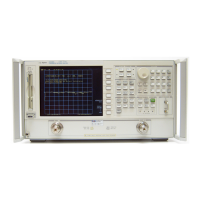7-138 Chapter7
Programming Examples
Limit Line and Data Point Special Functions
Output Data Per Range of Points
The GPIB command OUTPDATR returns the value of the selected points using FORM4
(ASCII). This ASCII format requires many data bytes per point for transfer. For a large
number of points, it may be faster to make trace data dumps (OUTPDATA) using a binary
format. The range of points is selected using the SELMINPT and SELMAXPT commands
(select minimum point, select maximum point of desired point range). These commands
return the last max point if the selected points are out of range. Only the SELMAXPT will be
returned if the selected minimum point is greater than the selected maximum point.
The commands in the following example are sent while using the format command LOGM.
Example:
Sending SELMINPT5, SELMAXPT7 and OUTPDATR may return the following:
3.880465E−01, 0.000039E−01
1.901648E−01, 1.363988E+11
5.57587E−01, 1.258655E+30 (Note that the second number is insignificant.)
For an explanation of these results see Table 7-20.
NOTE A new line feed character <
L
F
> is inserted after the segment number and
after each data pair.
Table 7-20 is an interpretation of the min/max data per range of points returned using the
SELMINPT5, SELMAXPT7 and OUTPDATR commands.
Output Limit Pass/Fail by Channel
The GPIB commands OUTPLIM1 and OUTPLIM2 output the status of the limit test for
channel 1 and channel 2, respectively.
These commands return the values 1 (PASS), 0 (FAIL), or −1 (NO_LIMIT) if limit testing is
disabled. Currently, the results of limit testing can be retrieved by reading a bit in the
status register.
Example:
Sending OUTPLIM1 or OUTPLIM2 (channel 1 or channel 2) may return the following:
1 (PASS), 0 (FAIL), or if limit test not enabled then −1 (NO_LIMIT).
Table 7-20 Example Output: OUTPDATPR (data per range of points)
Point Value Value*
5 0.3880465 0.000039E−01
6 0.1901648 1.363988E+11
7 0.557587 1.258655E+30
* These values are insignificant.

